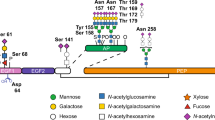Abstract
The importance of mammalian cell cultures for biotechnological production processes is steadily increasing, despite the high demands of these organisms on their culture conditions. Efforts towards a more efficient bioprocess generally concentrate on maximizing the culture's life time, the cell number, and the product concentration. Here recombinant BHK 21 c13 cells are used to produce rh-AT III, an anticoagulant of high therapeutic value. The influence of the process mode (batch, repeated batch, continuous perfusion) and the process temperature (30°C vs. 37°C) on the above mentioned parameters is investigated. It is possible to increase the length of the culture from 140 h (batch) to more than 500 h (continuous perfusion culture), while concomitantly increasing the cell density from 0.72 106/ml (batch) to 2.27 106/ml (repeated batch) and 2.87 106/ml (continuous perfusion culture). The accumulation of toxic metabolites, such as lactate, can be curtailed by reducing the bioreactor temperature from 37°C to 30°C during the later part of the exponential growth phase. Fast and reliable product monitoring became essential during process optimization. Capillary zone electrophoresis (CZE) in uncoated fused silica capillaries was studied for that purpose and compared to the standard ELISA. Under optimized conditions an AT III quantification could be done within 2 min with CZE. The detection limit was 5 μg/ml. A relative standard deviation of less than 0.9% was calculated. The detection limit could be lowered by one order of magnitude by using a two dimensional system, where an liquid chromatographic (LC) system is coupled to the CZE. Concomitantly the resolution is improved. The two-dimensional analysis required 5 min. Membrane adsorbers (MA) were used as stationary phase in the LC-system, to allow the application of high flow rates (5–10 ml/min). The correlation between the LC-CZE analysis and the standard AT III-ELISA was excellent, with r2: 0.965. Using the assay for at line product monitoring, it is shown, that the process temperature is of no consequence for the productivity whereas the process mode strongly influences this parameter.
Similar content being viewed by others
References
Banke N, Hansen K and Diers I (1991) Detection of enzyme activity in fractions collected from free solution capillary electrophoresis of complex samples, J. Chromatogr. 559: 325–335.
Bushey MM and Jorgenson JW (1990) Automated instrumentation for comprehensive two-dimensional high-performance liquid chromatography/capillary zone electrophoresis, Anal. Chem. 62: 978.
Freitag R (1996) Application of HPCE-Analysis to Process Monitoring in Biotechnology, in Parvez H, Caudy P, Parvez S, Gosselin P (eds.) HPCE in Biotechnology and Environmental Analysis. Progress in HPLC-CE, Vol. 6, VSP Int. Sci. Press, Zeist, The Netherlands, in press.
Hurni WH and Miller WJ (1991) Analysis of a vaccine purification process by capillary electrophoresis. J. Chromatogr. 559: 337–343.
Karger BL, Cohen AS and Guttman A (1989) High-performance capillary electrophoresis in the biological sciences, J. Chromatogr. 492: 585–614.
Kretzmer G, Ludwig A, Weidemann R, Teige M and Tomeczkowski J (1994) Growth and productivity of animal cells: A contribution to some factors influencing both (in press).
Li SFY (1992) Capillary Electrophoresis. Elsevier Amsterdam.
Mourey L, Samama JP, Delarue M, Larmeau JC, Petitou M and Moras D (1990) Antithrombin III: Structural and functional aspects, Biochimie 72: 599–608.
Reif OW and Freitag R (1993) Characterization and application of strong ion-exchange membrane adsorbers as stationary phases in high-performance liquid chromatography of proteins, J. Chromatogr. A 654: 29–41.
Reif OW, Lausch R and Freitag R (1994) Application of capillary electrophoresis to the quantitative and qualitative analysis of serum proteins, Am. Lab. June: 10–18.
Schügerl K, Graf H, Kretzmer G, Freitag R, Scheper Th and Wentz D (1990) Monitoring nutrient components, metabolites, product concentrations and the behaviour of animal cells in bioreactors. Proc. 5th European Congr. Biotechnol., Copenhagen. Christiansen C, Munck L and Villadsen J (eds.) Munnksgaard Internat. Publisher, Copenhagen, Vol I: 486–489.
Travis J and Salvesen S (1983) Human plasma proteinase inhibitors, Ann. Rev. Biochem. 52: 655–709.
Vinther A, Petersen J and Soeberg H (1992) Capillary electrophoretic determination of the protease Savinase in cultivation broth, J. Chromatogr. 608: 205–210.
Weidemann R, Ludwig A and Kretzmer G (1994) Low Temperature Cultivation — A step towards process optimization, Cytotechnol., submitted.
Wenisch E, Tauer C, Jungbauer A, Katinger H, Faupel M and Righetti PG (1990) J. Chromatogr. 516: 133.
Wentz D and Schügerl K (1992) Influence of lactate, ammonia and osmotic stress on adherent and suspension BHK cells, Enz. Microb. Technol. 14: 68–75.
Yamamoto H, Manabe T and Okuyama T (1990) Apparatus for coupled high-performance liquid chromatography and capillary electrophoresis in the analysis of complex protein mixtures, J. Chromatogr. 515: 659.
Zettelmeissl G, Wirth M, Hauser H and Kuepper HA (1988) Efficient expression system for human antithrombin III in baby hamster kidney cells, Behring Inst. Mitt. 82: 26–34.
Author information
Authors and Affiliations
Rights and permissions
About this article
Cite this article
Freitag, R., Reif, OW., Weidemann, R. et al. Production of recombinant h-AT III with mammalian cell cultures using capillary electrophoresis for product monitoring. Cytotechnology 21, 205–215 (1996). https://doi.org/10.1007/BF00365343
Received:
Accepted:
Issue Date:
DOI: https://doi.org/10.1007/BF00365343




